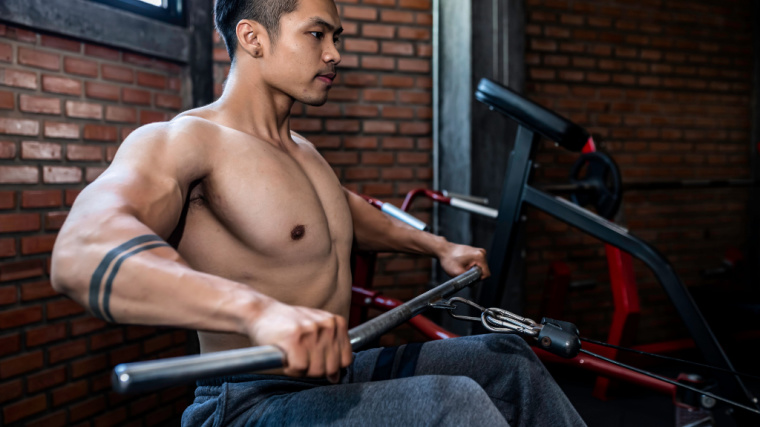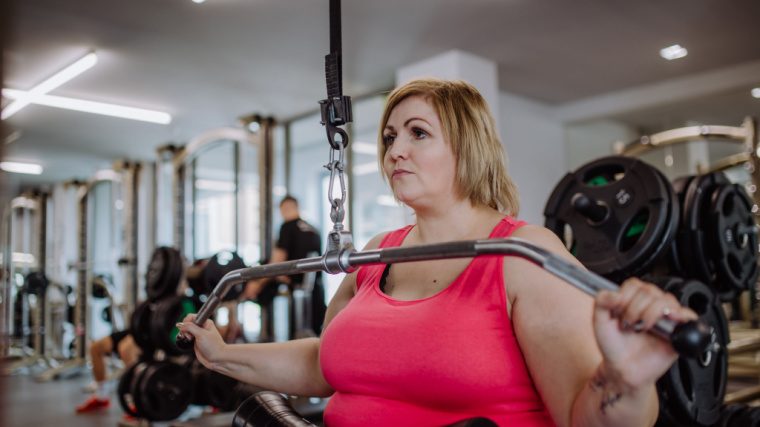Building out your first bodybuilding program can be a fun game of “how much do I have to do to get ripped?” Many new lifters find themselves stuck down the rabbit hole — painstakingly trying to figure out how to cram every exercise possible into each workout.
Unfortunately, playing bingo with the list of equipment in your gym won’t be the best way to build muscle — but the time tested push-pull-legs training split can work wonders.

Pairing of exercises that seemingly “go together” has been a staple in muscle building routines seemingly since the beginning of time. The muscle of the back and biceps form a dream team, dramatically streamlining your workouts and letting you improve throughout your training career. Here are the best back and biceps workouts for your experience level.
Best Back and Biceps Workouts for Your Experience Level
- Beginner Back and Biceps Workout
- Intermediate Back and Biceps Workout
- Advanced Back and Biceps Workout
Beginner Back and Biceps Workout
If you want to make your whole body muscular and strong, you’ll want to perform a solid mix of compound exercises and smaller isolation style exercises. If you’re a beginner, learning some of the fundamental exercises — such as a barbell row — can set you up for long term success.
You’ll often find that these kinds of moves work out your back and biceps at the same time. You’ll generate a lot of strength and body awareness with big, full body movements. Then, isolation exercises fill in the gaps by building up your smaller muscles (in this case, your biceps).
The Workout
As a beginner, it’s often best to combine muscle groups instead of working one muscle group at a time. However, when you’re featuring a move like the barbell row, it might come with obstacles.
You’ll be putting a lot of effort into increasing your strength and skill with this first lift of the day. To accommodate the fatigue that comes with that effort, the remaining exercises should be a bit easier.
- Barbell Row: 3 x 8-10
- Close-Grip Lat Pulldown: 3 x 12
- Machine Reverse Flye: 3 x 12-15
- Dumbbell Hammer Curl: 3 x 10
Using machine-based exercises that stabilize your movement patterns will be very helpful here.
How to Progress
Since you’re trying to make progress as a beginner here, progressive overload will be your biggest driver of success. Slowly work to add weight across each exercise, emphasizing the barbell row first before advancing the smaller exercises.
Gradually progress your set and repetition schemes for each exercise to a cap of three to four sets of 10 to 12 repetitions with clean form. Once you’ve accomplished this, you can start thinking about jumping into a more challenging program.
Intermediate Back and Biceps Workout
Once you’ve entered the intermediate experience level, you should be able to handle a few more exercises per workout. You’re still not trying to slam everything together into one mega-session, but considering how much muscle mass is involved in the back, a couple more won’t hurt.

You can apply this same logic to your arms, as well. But since your arms are almost always being worked by back exercises, you won’t need nearly as many biceps exercises.
The Workout
At this stage, you should start making your exercises a bit more challenging by going unilateral — one side at a time — by using some dumbbells. Unilateral exercise such as the single-arm dumbbell row will help with your core stability and coordination.
- Single-Arm Dumbbell Row: 3 x 10 per arm
- Single-Arm Lat Pulldown: 3 x 12 per arm
- Chest-Supported T-Bar Row: 3 x 10
- Cable Rear-Delt Flye: 3 x 12-15
- EZ-Bar Preacher Curl: 3 x 10
- Incline Dumbbell Biceps Curl: 2 x 12-15
As a muscle-building bonus, unilateral cable or dumbbell work will also make it a bit easier to align each exercise specifically to the muscle groups you really want to emphasize.
How to Progress
As a beginner, adhering to the principles of progressive overload is a great tool to allow you to build skill and muscle at the same time. Now that you’re at an intermediate level, trying to peak your training intensity while maintaining good technique should be your priority.
Muscle growth relies on strenuous repetitions. Increasing volume is one way to help achieve these reps, but focusing on high-quality intensity is key. You’re likely to see a bump in progress if you aim for a high end-of-set rating of perceived exertion (RPE) — AKA, the end of each set should be tough.
Advanced Back and Biceps Workout
Advanced lifters often begin to accumulate some movement restrictions from how hard training has become. Do yourself a favor and start your workout with a bit of a “reset.”

Use some exercises to get your shoulders and back prepared to go through the required ranges of motion. A high-cable biceps curl supersetted with a face-pull before you get into the main workout can help set the table for a much better performance.
The Workout
Although you’re an advanced lifter, there’s still only so much time or intensity you can allocate to any workout before diminishing returns kicks in. Once you’re tired, you’re tired.
There’s no sense beating yourself down any further. Instead, lead with strength, keep a good amount of unilateral exercises involved, and train close to failure.
- High-Cable Biceps Curl superset with Face-Pull: 2 x 12-15 per exercise
- Pendlay Row: 3 x 6
- Single-Arm Dumbbell Row: 3 x 8
- Wide-Grip Pulldown: 3 x 12
- Rear-Delt Cable Row: 3 x 10-12
- Alternating Dumbbell Biceps Curl: 3 x 8-10
- Standing Incline Cable Biceps Curl: 2 x 12-15
How to Progress
As an advanced lifter, skill becomes important all over again. Unlike beginners and intermediates, seeing progress in the logbook might take a great deal longer than when you were new. Keep exercises in the same training program for a longer period of time and allow your skilled execution and intensity to slowly rise. To put it another way, discipline is your progression here.
Muscle at this stage will take longer to grow, and program hopping may be much more detrimental than in beginner or intermediate phases. Design workouts to attack the muscle groups you’re trying to bring up, then strap in for the long(er) haul. Utilizing a periodized program to organize months of training at a time is often your best bet here.
Anatomy of the Back and Biceps
The back and biceps bring together two muscle groups that act extremely synergistically. Any back exercise that calls on you to bend your elbows will inherently recruit some biceps. It makes sense to keep them paired. With that in mind, there are also a huge number of individual back muscles to design each workout around.
Traps
The traps are a large diamond shaped muscle group that envelop the upper and middle parts of your back. They span essentially from your neck, between your shoulder blades, and finish a bit below the inferior angle of the scapula.
Given this, any exercise that manipulates your scapula will likely call upon your traps. But the big meat and potatoes exercises will be anything (particularly rows) that cause scapular retraction (think: pulling).
Lats
The lats are one of the biggest muscle groups of the body and certainly the biggest of the back. They originate from many points across the entire posterior side of your body, from your low back to your hips and into your rib cage area.
This means you want to pepper various angles of rows and pulldowns throughout your program over time. Then, you can truly attack your lats from every possible angle.
Rhomboids
The rhomboids are a muscle group pocketed neatly between your shoulder blades and your spine. They primarily act to retract your shoulder blades, so many of the exercises you’ll perform for your middle traps will also target the rhomboids. A healthy amount of overhand grip rowing will be a nice dose of stimulus here.
Rear Delts
The rear delts serve as a trophy muscle for any well-developed back. They sit nicely atop of where your lats seem to end. The rear delts help to draw your arm bones back behind your body (horizontal abduction). Reverse flyes and certain angles of overhand grip rowing will help isolate them.
Spinal Erectors
An honorable mention for back day is the spinal erectors. Most people think of the erector spinae when they think of spinal erectors — this is the small patch of muscle near the spine at the low back.
The reality is that your spinal erector group travels the length of your spine from low to high. They’re involuntarily recruited in most (if not all) exercises that require you to hinge. Bent-over rows are a great way to get some stimulus on these muscles over the long haul.
Biceps Brachii
Your biceps brachii are one of the major muscles of your arms. When you’re thinking about biceps training, this is usually where your mind goes. They act to primarily flex the elbow, so any number of curl variations can help build up your biceps.
The biceps brachii also have subtly different origin points (since they have two distinct muscle bellies). The trick for long term gains is to spice small changes to your grip or arm angle over the years.
Brachialis
The brachialis is another muscle that sits on the front of your arm and crosses your elbow. Its primary action is to serve as a strong elbow flexor. Most exercises that you’ll perform to target your biceps brachii will spillover to your brachialis as well.
Brachioradialis
The brachioradialis is the large muscle that sits at the top portion of your forearm. It’s another muscle group that can help flex the elbow. A good way to target it is with a neutral grip exercise such as a hammer curl, placing the brachioradialis front and center for force production.
Benefits of Training the Back with Biceps
The benefits of combining your back and biceps training comes down to the ability to better target your back and arms. It can also help with secondary perks — such as shoulder stability — along the way.
Chiseled Back
Using a body part split such as push-pull-legs really helps target each of the finer muscle groups within your back. While certain exercises such as barbell rows or deadlifts help to recruit many of the muscles together, you’ll get the best muscle building results by breaking your physique down into the individual components.
Pairing your back and biceps workouts helps you allocate as much time and energy as possible to the many muscles of your back. This way, you’ll still have some gas in the tank to finish your arms after their hard work over the entire workout.
Huge Arms
You can certainly train your arms on their own day. But it’s even more efficient to pair them with a muscle group that they’ll already be helping anyway. Each pulldown and row that you perform will inherently recruit some biceps. You’ll slowly accumulate stimulus across your workout.
Choose one to two biceps-specific exercises to really dig in on at the end of the workout. This will help you build some serious muscle on your arms without dedicating an entire day out of your training program.
Stable Shoulders
Back and biceps training can be a huge asset to keeping your shoulders happy and healthy. Using overhead exercises like single-arm lat pulldowns or high-cable biceps curl can hone your ability to stabilize your shoulders overhead. Combine this with some rear delt work or face pulls and you should be able to hit your shoulder stability goals.
Back Up Your Biceps
Back and biceps — the iconic duo. Aside from the notorious chest and triceps pairing, you’d be hard pressed to find another pairing of muscles that synergize so well.
If you’re looking to build the most effective training split for muscle gain, combining your back and biceps into one workout performed twice per week is one of the best options you have. It’s time efficient, muscle-building, and will let you hit everything you need. A good back and biceps workout is a guaranteed hit — regardless of your experience level.
Featured Image: kittirat roekburi / Shutterstock